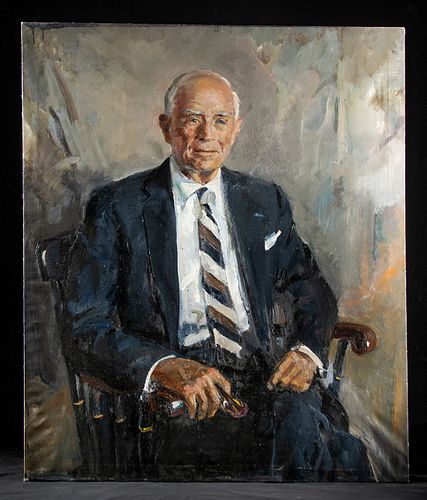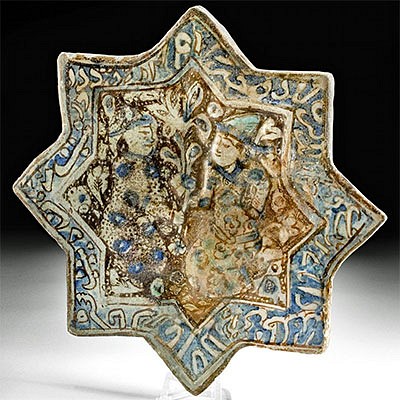William Draper Portrait of Mature Gentleman, ca. 1980s
Lot 346
About Seller
Artemis Fine Arts
686 S Taylor Ave, Ste 106
Louisville, CO 80027
United States
Selling antiquities, ancient and ethnographic art online since 1993, Artemis Gallery specializes in Classical Antiquities (Egyptian, Greek, Roman, Near Eastern), Asian, Pre-Columbian, African / Tribal / Oceanographic art. Our extensive inventory includes pottery, stone, metal, wood, glass and textil...Read more
Estimate:
$900 - $1,200
Absentee vs Live bid
Two ways to bid:
- Leave a max absentee bid and the platform will bid on your behalf up to your maximum bid during the live auction.
- Bid live during the auction and your bids will be submitted real-time to the auctioneer.
Bid Increments
| Price | Bid Increment |
|---|---|
| $0 | $25 |
| $300 | $50 |
| $1,000 | $100 |
| $2,000 | $250 |
| $5,000 | $500 |
| $10,000 | $1,000 |
| $20,000 | $2,500 |
| $50,000 | $5,000 |
| $100,000 | $10,000 |
| $200,000 | $20,000 |
About Auction
By Artemis Fine Arts
May 20, 2021
Set Reminder
2021-05-20 10:00:00
2021-05-20 10:00:00
America/New_York
Bidsquare
Bidsquare : Ancient & Ethnographic From Around The World
https://www.bidsquare.com/auctions/artemis-gallery/ancient-ethnographic-from-around-the-world-6979
Ancient art from Egypt, Greece, Italy and the Near East, as well as Asian, Fossils, Pre-Columbian, Native American, African / Tribal / Oceanic, Fine art, and much more! All categories, all price ranges... all legally acquired and guaranteed to be as described or your money back. Artemis Fine Arts info@artemisgallery.com
Ancient art from Egypt, Greece, Italy and the Near East, as well as Asian, Fossils, Pre-Columbian, Native American, African / Tribal / Oceanic, Fine art, and much more! All categories, all price ranges... all legally acquired and guaranteed to be as described or your money back. Artemis Fine Arts info@artemisgallery.com
- Lot Description
William Franklin Draper (American, 1912-2003). Untitled portrait - oil on canvas, ca. 1980s. A formal portrait of a distinguished elderly gentleman painted by American artist William Draper. While the subect is unknown, William Draper was highly respected as a portraitist, and this sitter was undoubtedly a man of distinction. In this composition, the gentleman is seated in a black and gold painted wooden Windsor chair, with his legs crossed with hands placed upon his knees. He wears a charcoal grey suit with a striped tie of coordinating black, red, and white hues, a white dress shirt, and a matching handkerchief in the breast pocket. He holds his eyeglasses in his right hand and looks out at the viewer with twinkling blue eyes and a disarming smile. Size: 44" L x 37" W (111.8 cm x 94 cm)
In addition to capturing the sitter's august nature, Draper demonstrates wonderful command of his technique in this piece. Just look at the brushwork on the face, especially the passages around his eyes, for example. A remarkably veristic portrait by William Draper who became known as the "Dean of American portraitists"!
Boston MFA Director Emeritus Peter Rathbone compared Draper's skill to that of master John Singer Sargent. Rathbone, whose portrait Draper also painted stated, "Nature endowed William F. Draper with enough talents to require him to choose among them before embarking on a professional career. Yet to those who know him, it is hard to imagine that any natural bent could rival his personal endowment as a painter of portraits … Draper's painting belongs to the tradition of Sargent. Like Sargent's, his style is fluid with virtuoso brushwork as the identifying characteristic. Like Sargent, the preparation of the painting by Draper is all in the artist's eye. Unlike Sargent's detachment, Draper's understanding and love of people and his appreciations of physical subtleties are happily projected into his work. These traits are the source of the warmth and vitality of his portraiture. They are also the reasons why his portraits are fine likenesses. And it is not too much to say that something of his own vibrant personality is reflected in everything he paints." ("Portraits Period" by Portrait Brokers of America, 1990, p. 46)
William Draper's career spanned seven decades and his subjects included a portrait of John F. Kennedy that hangs in the National Portrait Gallery in Washington D.C. based upon an oil sketch for which the president sat in 1962. Draper was actually the only artist who painted JFK from life. Draper showed at Knoedler, the Graham Gallery, Portraits, Inc., the Far Gallery, The Findlay Galleries (New York, NY) and the Robert C. Vose Galleries (Boston, MA). His work has been included in shows at the National Portrait Gallery and the Corcoran Gallery of Art (Washington, D.C.), The National Academy of Design (New York, NY), The Boston Museum of Fine Arts, (Boston, MA) the Fogg Art Museum, (one of the Harvard Art Museums, Cambridge, MA), the National Gallery, (London), Salon de la Marine (Paris) and in museums in Australia. He also taught at the Art Students League of New York, and received a lifetime achievement award from the Portrait Society of America in 1999.
More on the artist's background: William Franklin Draper was born in Hopedale, Massachusetts on December 24, 1912. A child prodigy, he studied classical piano at Harvard University. He later changed his focus to fine art and studied with Charles Webster Hawthorne and Henry Hensche in Provincetown, Rhode Island. Draper also attended the National Academy of Design in New York and the Cape Cod School of Art in Massachusetts. Then he traveled to Spain and studied with Harry Zimmerman, moved on to France and attended the Academie de la Grande Chaumiere. In 1937, he moved to Boston to study sculpture with George Demetrius and also studied with Jon Corbino in beautiful Rockport, Massachusetts. In 1942, Draper joined the Navy and served as a combat artist when stationed on the Aleutian Islands and in the South Pacific. He observed and painted battle scenes on Bougainville, Guam, Saipan, and other locations, as well as genre scenes of soldiers who were not engaged in combat but rather at work and at play. National Geographic magazine reproduced 25 of his war images in four issues in 1944. In 1945, the Corcoran Gallery of Art in Washington D.C. organized a group exhibition of works by five official war artists, including Draper. That same year the Metropolitan Museum of Art included Draper in an exhibition entitled, ''The War Against Japan.'' Draper was also featured in a PBS television show about combat artists entitled, "They Drew Fire" in May of 2000. After the war, Draper opened a studio on Park Avenue in New York City and continued to not only paint, but also play classical and jazz piano.
Provenance: The William F. Draper Collection, New York City, New York, USA, acquired via descent from the late William Franklin Draper (1912-2003)
All items legal to buy/sell under U.S. Statute covering cultural patrimony Code 2600, CHAPTER 14, and are guaranteed to be as described or your money back.
A Certificate of Authenticity will accompany all winning bids.
We ship worldwide and handle all shipping in-house for your convenience.
#152831Painting is in excellent condition. Draper Estate stamp on verso.Condition
- Shipping Info
-
All shipping is handled in-house for your convenience. Your invoice from Artemis Gallery will include shipping calculation instructions. If in doubt, please inquire BEFORE bidding for estimated shipping costs for individual items.
-
- Buyer's Premium



 EUR
EUR CAD
CAD AUD
AUD GBP
GBP MXN
MXN HKD
HKD CNY
CNY MYR
MYR SEK
SEK SGD
SGD CHF
CHF THB
THB













